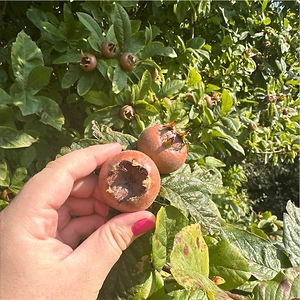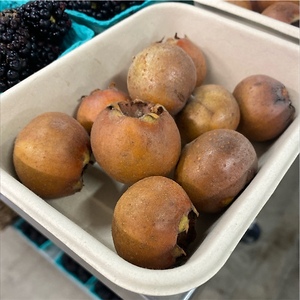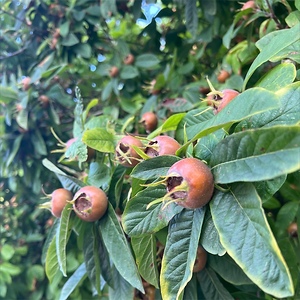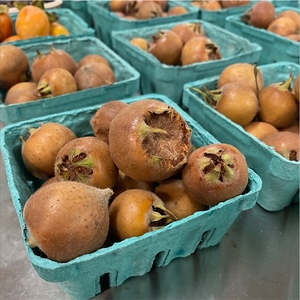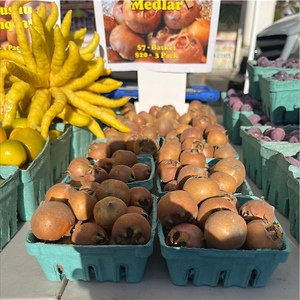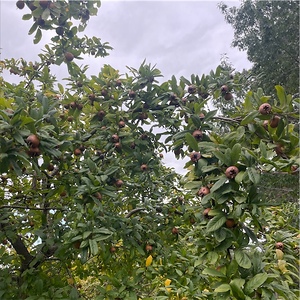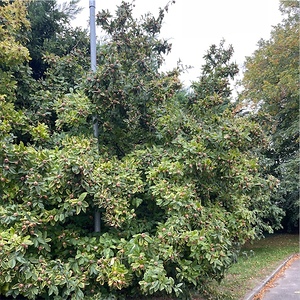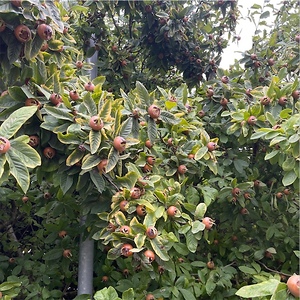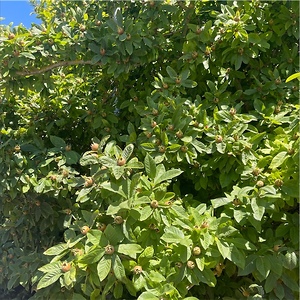

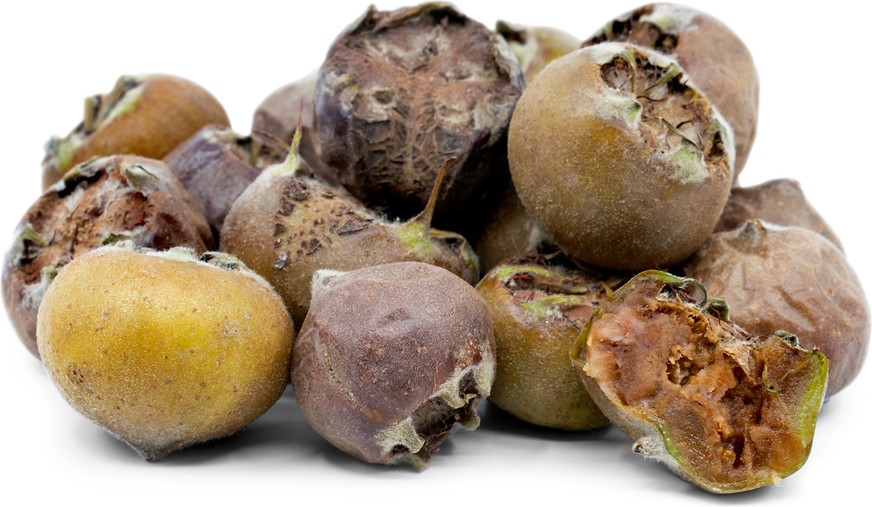
Medlar
Estimated Inventory, lb : 0
Description/Taste
Medlar fruits are small, averaging 2 to 5 centimeters in diameter, and have a round to slightly flattened, ovate shape with a distinct, open blossom end bearing multiple sepals. When unripe, the fruits have firm, taut, and textured skin, ranging in color from golden, light brown, to orange-brown. The flesh is also dense, cream-colored, and hard when young, encasing a few inedible seeds, and contains high amounts of tannins and acidity. As the fruit is left to mature, a process known as bletting, the skin will darken and wrinkle while the flesh develops a soft, sticky, and creamy consistency and transform into a dark brown hue. Bletting allows the tannins and acidity in the flesh to reduce, and it is important to note that is process is not the fruit rotting but fully ripening. Once bletted, Medlar fruits develop a consistency and flavor similar to applesauce or apple butter and have a tangy and sweet taste with subtle notes of cinnamon, vanilla, apples, and citrus.
Seasons/Availability
Medlar fruits are available in the late fall through winter.
Current Facts
Medlar, botanically classified as Mespilus germanica, is an ancient fruit belonging to the Rosaceae family. The small, rosehip-like fruits grow on deciduous trees that can reach up to 8 meters in height and were one of the few fruits to ripen during the winter in temperate climates throughout Europe and Southwestern Asia in the Middle Ages. Medlar trees have been cultivated for thousands of years as an ornamental cultivar, and there are many different varieties, with royal and nottingham being the most widely grown types. The trees are also cultivated for their edible fruits that require a unique ripening process known as bletting, where the fruits are left to fully ripen, changing in appearance, texture, and flavor. Medlar has a rich history in culinary applications and has been mentioned in many literary works of Cervantes, Shakespeare, Nabakov, and D.H. Lawrence. Despite the fruit’s popularity throughout history, Medlar eventually fell out of favor to new fruits that were developed to be eaten straight off the tree without the need for bletting. In the 21st century, Medlar is rare, not commercially cultivated, and is slowly reemerging as a specialty fruit sold through select growers for chefs, food enthusiasts, and home cooks.
Nutritional Value
Medlar fruits are an excellent source of vitamin C to boost the immune system and are a good source of iron, a mineral that helps produce the protein hemoglobin that carries oxygen within the bloodstream. The fruits also contain calcium to strengthen bones and lower amounts of vitamin B1, potassium, magnesium, and fiber.
Applications
Medlar fruits must be bletted before they are utilized in culinary applications. Bletting is a ripening process generally lasting 2 to 4 weeks to allow the fruits time to soften in texture and develop sweeter flavors. Once bletted, Medlar fruits can be eaten raw on their own, discarding the skin and consuming the flesh, or they can be stewed or baked into sweet applications such as tarts, pies, and cakes. Medlar fruits also make a rich fruit jelly that can be spread on toast, served with blue or hard salty cheeses, stuffed into baked apples, or slathered on roasted meats. In Europe, the pulp is traditionally mixed with sugar and cream and consumed as an accompaniment to wine. The fruits can also be added to yogurts as a sweet topping. Medlar fruits pair well with cream cheese, blue cheese, spices such as cloves, cinnamon, and cardamom, fruits such as apples, quince, and plums, and meats such as lamb, pheasant, poultry, and pork. Whole, unripe Medlar fruits will keep 3 to 4 weeks when stored in a cool, dry, and dark location. Once bletted and fully ripe, the fruits should be consumed immediately for the best quality and flavor.
Ethnic/Cultural Info
Six Medlar trees can be found in the gardens of Grimsthorpe Castle in Lincolnshire, England. The 3,000-acre property belongs to the Willoughby de Eresby family and has been passed between generations for over 500 years. Surrounding the castle, there are multiple gardens filled with flowers, vegetables, and fruit trees. The six Medlar trees are located along the east side of the castle, and the tops of the trees are pruned into a domed, mushroom-like shape. For most of the year, the Medlar trees are primarily seen as a unique ornamental, paying homage to the fruit’s popularity among British nobility during the Victorian Era, but in the late fall and winter, the fruits are gathered for holiday celebrations. It has been reported that Lady Willoughby, the granddaughter of Nancy Astor and current resident of the castle, traditionally eats the bletted fruits mixed with cream as an accompaniment to port. The fruits are also cooked with allspice and sugar and are molded into ornate shapes, creating the famous spread known as Medlar cheese. The molded fruit paste was created in the Victorian Era for its outlandish presentation and was frequently served with salty cheeses, wine, and toast. In the modern-day, it is a favored Christmas dish.
Geography/History
Medlar trees are native to Iran, present-day Turkey, the Caucasus region, and other areas of Southwestern Asia, located just east of the Mediterranean. The ancient fruits have been cultivated for over 3,000 years and were widely used during the Greek and Roman empires. Medlar fruits were later introduced to Western Europe and grew increasingly popular as a winter fruit until new late-ripening fruit varieties were introduced in the early 20th century, diminishing the value of Medlar due to the variety’s bletting requirement. The fruits were also brought to California sometime in the 19th century, but they were never selected for large scale commercial production. Today Medlar fruits can be found in their native range and are also grown on a small scale throughout Europe, Asia, Australia, Canada, and the United States. The fruit trees exist in both the wild and in cultivated orchards, where they are generally grafted rather than grown from seed to maintain consistent fruit sizes.
Recipe Ideas
Recipes that include Medlar. One
Podcasts



